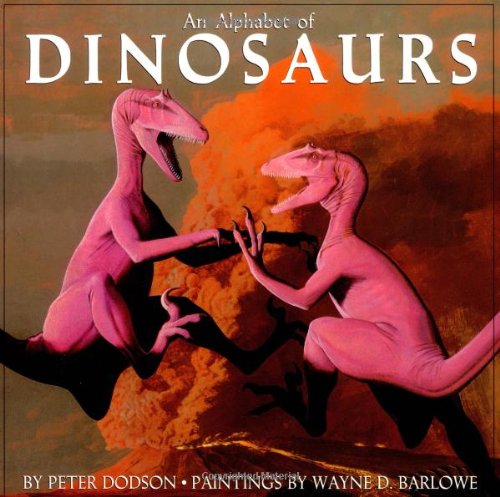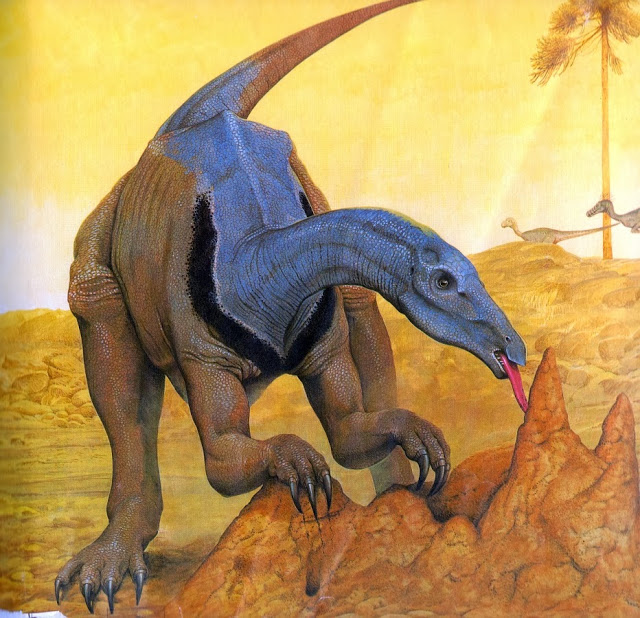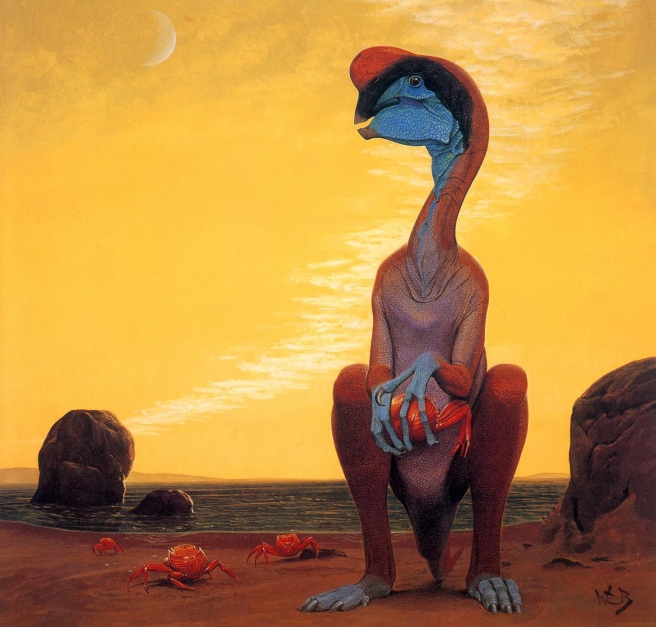
I have many memories of enjoying An Alphabet of Dinosaurs as a kid, mostly thanks to Wayne D. Barlowe’s gorgeous illustrations.
While in grades 1-3 (about the target audience of the picture book), I borrowed An Alphabet of Dinosaurs from my school library a lot. It spent a lot of time in my backpack, on my kitchen table, and on my bedroom floor. I remember sitting with it in the car or just before bed, flipping the big pages and drinking in the striking images.
I recently picked it up again, curious how it would compare to my early memories, and I found the paintings to be just as fascinating as I remembered. Part of the appeal comes from the formatting of the book itself, and from the careful composition of the paintings. Even in my adult hands the pages are large, with illustrations taking up the entirety of every second page with no borders of any kind. The dinosaurs themselves don’t fill the majority of these images – there’s always room for detailed landscapes, and often other species inhabiting the environment. This creates the feeling that you are stepping into a dynamic world… And with 26 full illustrations, there’s a lot of world for young readers to explore.

It’s obvious that pains were taken to make the dinosaurs and their world feel as real as possible – some illustrations remind me of sci-fi illustrations that depict aliens on distant planets. The author explains the reasoning behind this artistic choice in the introduction:
The paintings in this book show dinosaurs as we now think of them. Gone is the image of slow-moving giants. Gone is the image of tail-dragging lizards. Instead, we see vibrant, active dinosaurs living in a world filled with brightly coloured animals and plants.

I think it’s worth noting that, even though these depictions of dinosaurs were forward-thinking when the book was first published in 1995, palaeontology has changed enough in the past 21 years to make these illustrations noticeably outdated. In a modern version of this book, you would see feathers covering almost all of the theropods. Additionally, the illustrations often “shrink wrap” their subjects – “pulling” the skin too tight over the skeleton without taking fat and muscle into sufficient account.
These issues are to be expected, given that palaeontology is constantly moving forward. It’s encouraging to me to think that this kind of paleoart has gone from new and innovative to outdated within my lifetime.

I haven’t yet mentioned the actual “alphabet” in this Alphabet of Dinosaurs, and there’s a reason for that. As a child, I wasn’t actually able to read the text (and, as an adult, I still find the illustrations to be by far the most interesting part of the book).
The written portion of the book progresses as you would expect most alphabet books to: first the book names a dinosaur, the first letter enlarged for emphasis. Ankylosaurus, Baryonyx, Chasmosaurus, and so forth. This is followed by two or three sentences, providing some facts about the creature.
I think that as a child I had several issues with the text that prevented me from reading it. One was the use of large and sometimes difficult-to-understand words. I’ll provide an example:
Leptoceratops was a tiny, distant cousin of the triceratops. Since its front legs were so much shorter than its back legs, some scientists think it may have run on its long hind limbs.
Sure, it’s easy enough to understand as an adult. But many of the words are long, difficult to sound out, or simply confusing for a child still learning to read.
Another issue is the size of the text. While large text normally makes for easier reading, the compact positioning of the sentences on the page combined with the font size creates the illusion of a dense paragraph, or at least it did to my eyes as a child.

I probably would have fared better if an adult had read the book to me (which was probably the intent of the author – he even includes a pronunciation guide for the dinosaur names at the back of the book). Still, I think it’s at least worth noting that the book ultimately doesn’t work well as an alphabet book. It’s more like a book of interesting dinosaur facts that just happens to be organized alphabetically.
Despite my criticism, I do actually love this book. It didn’t necessarily teach me much as a child, but it did seriously inspire my imagination. The time I spent gazing in wonder at the pictures lead me to pick up dinosaur books that I did learn a lot from in later years. While the text didn’t do much for me, after reading through it recently I do think it includes some really interesting facts that a child might enjoy at the right reading level or with the proper guidance.
Overall, even though the book is in some ways outdated, it’s still a touchstone from my childhood that I think deserves recognition.

